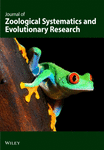Brains of Vespertilionids
I. Subfamily characteristics
Abstract
Macromorphology and encephalization (EI) of brains were compared in 58 Vespertilionid species, brain composition in 36 species: 46 or 27 species of Vespertilioninae, 8 or 5 species of Miniopterinae, 2 species of Kerivoulinae, and 2 species of Nyctophilinae. Subfamily differences were found in the extent of the cover of the mesencephalon. It is nearly fully covered in Kerivoula papulosa (Kerivoulinae), at least half covered (by the cerebellum) in Miniopterinae, and free (completely or nearly so) in Nyctophilinae and Vespertilioninae. In relative brain size, the Kerivoulinae are highest (average EI = 130), followed by the Miniopterinae (111), Nyctophilinae (102) and Vespertilioninae (95). The higher encephalization of Kerivoulinae and Miniopterinae is accompanied by a marked increase of relative size in cerebellum and striatum, and in Kerivoulinae, in hippocampus and neocortex as well.




